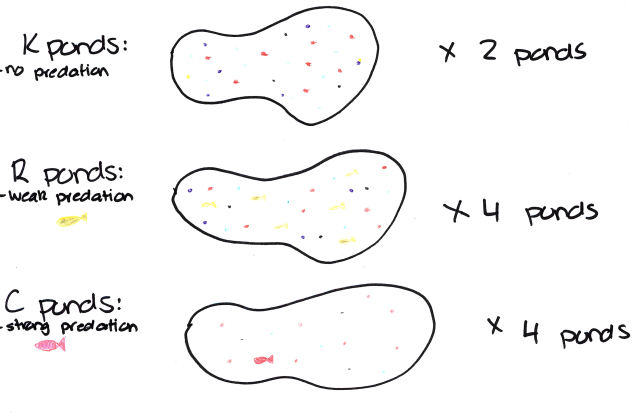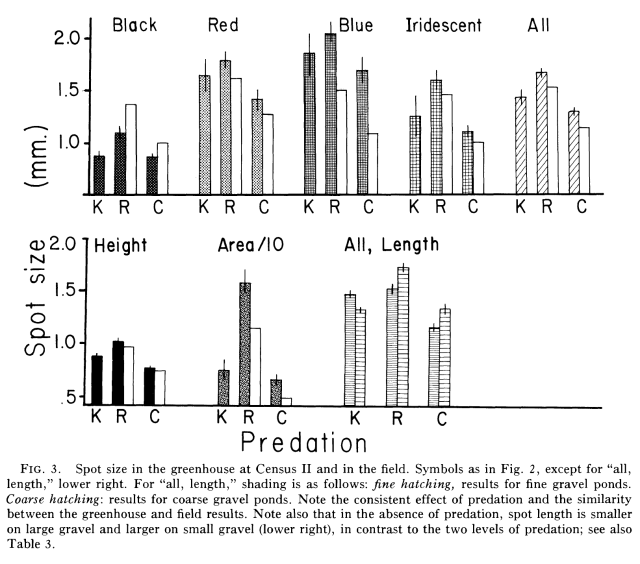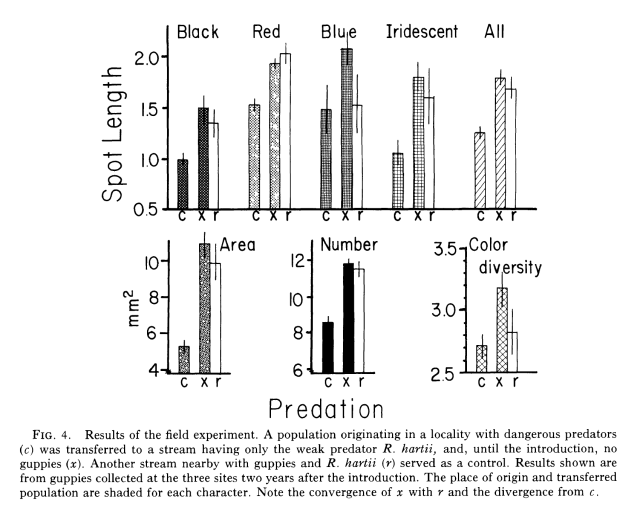Trying to find a paper on experimental evolution wasn’t an easy task for me. I found papers that I thought were interesting, but were lacking in experimental evolutionary methods and others that bored me to death. Personally guppies are what come to mind when I think about natural selection and evolution – being pretty and shiny is just an added bonus!
Natural selection: “the process whereby organisms better adapted to their environment tend to survive and produce more offspring. The theory of its action was first fully expounded by Charles Darwin, and it is now regarded as be the main process that brings about evolution” – wikipedia
Endler (1980) used guppies to look at two aspects of natural selection in both natural and artificial environments. He has been quite a prominent fixture in evolutionary mechanisms within guppies and provides an example of natural selection with the simplicity needed to grasp this topic by following colour patterns and spot sizes in these guppy populations. Guppies are common additions to household aquariums, but would generally be overlooked in terms of their importance in understanding evolution.
This experiment, which utilized the vast expanses and populations of guppies found in Northern Trinidad and Venezuela, demonstrates the impact of natural and sexual selection in these guppy populations. Its a simple, yet comprehensive, study that is still relevant today. Some websites have taken the fundamentals from this experiment and delivered in it a way that is fun and easy to understand. With that in mind, lets take a look at what Endler’s (1980) study entailed.
This is an awesome website that summarizes the experiments outlined in this paper!
Greenhouse Experiment

Artificial pools for greenhouse experiment
Ten artificial pools were set up that mimicked natural guppy environments. Two control
pools with no predators, 4 pools with the weak predators (Rivulus hartii) and 4 pools
with the dangerous predators (Crenichichla atla) were used for these experiments. For full details of the methods used in this study have a look at the paper by Endler (1980).

Timeline for greenhouse experiments
Endler (1978) had previously observed that predators influence male
color patterns and with this knowledge was able to predict the results from this experiment. Dangerous predators (Crenichichla) result in guppies with dull colors and smaller spots while weak predators (Rivulus hartii) result in guppies with brighter colour patterns and larger spots (Endler, 1978). Only male guppies exhibit these elaborate colour patterns – indicating an element of sexual selection, more on this later.
The figures that follow (Endler, 1980) support these previous observations (Endler, 197
8) and demonstrate the impact predation has on natural selection.

Endler, 1980

Endler, 1980

Endler, 1980
The colour pattern and spot sizes increased in the presence of weaker predators and decreased in the presence of dangerous predators (Fig. 1-3). Blue and iridescent (shiny) spots were seen to almost diminish in the presence of dangerous predators (Fig. 2 & 3). It was later suggested that blue and iridescent spots were highly reflective and eye catching to predators, so a decrease in the presence of dangerous predators is concurrent with this view as something yummy and shiny is easier to see when you’re looking for it, similar to spotting a donut with sprinkles as you walk past a bakery window.
With these findings in mind they then compared the results they obtained from the field experiments to see if similar results were drawn.
Field Experiment

Aripo Introduction site for natural experimental population
The field experiment used an isolated portion of a stream (Aripo I), with only the presence of the weak predator (Rivulus hartii), to relocate guppies from a high predation area (c) to a low predation area (x). In this experiment they expected to see a shift in colouration and spot size from that seen in high predation environments (dull colours and small spots) to low predation environments (colourful guppies with large spots). After two years the guppies in the Aripo Introduced population had phenotypes similar to that of guppies found in low predation environments (r), more colourful and displaying larger spots. This deviates from the high predation phenotype that was initially exhibited prior to translocation indicating natural selection within this population.

Endler, 1980
Habitual Background
The second parameter considered in this study was the influence gravel colour and size had on colour patterns and spot sizes in the guppies. If you think about it, for guppies in the presence of dangerous predators the better you are at blending into your surroundings the more likely you are to evade the lunch menu. With this in mind, colour patterns and spot sizes were observed and scored to see what influence this had on natural selection. It was observed that the overall body sizes were proportionate to the gravel backgrounds they inhabited and the colour proportions in the gravel background. This was more obvious in the greenhouse pools as the artificial gravel colours were brighter in some pools than others and this reflected in the results (Fig. 2-4).
Sexual Selection
Sexual selection is a concept that is prevalent in any social standing. People (and animals) choose a mate based on their ideal preferences. Generally, it can be considered what society deems as an appropriate fit but this ingrained preference goes a little deeper than that, even if we aren’t consciously aware of it. A study by Godin and Dugatkin (1996) looked at female mating preferences in guppies and identified their tendencies to mate with brightly coloured males. Surely this isnt based entirely on aesthetically pleasing characteristics? Godin and Dugatkin (1996) identified that males with brighter colours were more likely to approach predators in both the absence and presence of females. This resonates in many social situation where a male tries to portray his masculinity by challenging someone larger than him in order to woo a mate. This boldness ultimately leads to these characteristics being passed onto their sons and thus increasing genetic fitness of both parents. The protective element is always desirable as males exhibiting these characteristics are able to fend for and protect their families from danger and thus contribute, genetically, to the next generation.
I enjoyed looking at this paper again. I was first introduced to Endler and his guppies in my undergrad degree, where we were given a computer simulation that was based on this experiment. At the time I didn’t appreciate the intricacies of it, clicking aimlessly until it was time for lunch, but the concept stuck with me. It’s quite a cool concept to consider when you’re thinking about natural selection, as it is not only the predation element that is operating in this study but also sexual selection.
I had been watching a program on tv about fertility issues some couples face and later discussed this with my husband. With the addition of modern medicine and the ability to over come issues that would have initially stalled reproduction in some individuals, will this ultimately lead to an increase in the susceptibility of future generations? This can be applied to many evolutionary concepts where adaptation culls the weak and selects for the strong. If we are able to alter this selection process, what does that mean for the future? Will we see increasing amounts of people succumbing to illness? Is this changing the natural course of evolution? These are questions that I often think about and by looking at the current population its easy to see the shift. This is a deviation from what guppies can tell us at this point in time but simply put, only the strongest survive.
References
- Godin, J.-G.J. & L.A. Dugatkin, Female Mating Preference for Bold Males in the Guppy, Poecilia reticulata. Proceedings of the National Academy of Sciences of the United States of America, 1996. 93(19): p. 10262-10267.
- Endler, J.A., A Predator’s View of Animal Color Patterns, in Evolutionary Biology, M.K. Hecht, W.C. Steere, and B. Wallace, Editors. 1978, Springer US: Boston, MA. p. 319-364.
- Endler, J.A., Natural Selection on Color Patterns in Poecilia reticulata. Evolution, 1980. 34(1): p. 76-91.
- Amy E. Deacon, Hideyasu Shimadzu, Maria Dornelas, Indar W. Ramnarine & Anne E. Magurran. From species to communities: the signature of recreational use on a tropical river ecosystem, 2015. Ecology and Evolution 5 (23): 5561–5572. DOI:10.1002/ece3.1800. (Feature Image).

Surely, if only the strongest survive, then natural selection would not have been able to “select” for large-dotted, colourful guppies, as they would certainly not have been the “strongest” in the high predation area that they originally were relocated from? I think this is a key advantage of sexual reproduction; that it creates lots variation. We cannot know for sure, what predators or infectious agents might arise, or what environmental changes will happen at any time. So maintaining, if expanding, the gene pool is a really important factor that I think you have overlooked. Those guppies would not have been able to go back to being colourful and shiny, if there hadn’t remained weaker individuals in the population at the time of high selection pressures (predation). I think it’s the same for people. Rather than thinking of it as “changing the natural course of evolution” for the worse, I think medicine and technology being able to help survival chances of individuals that seem weaker now, might save us in the future. An example is sickle cell anaemia – it confers resistance to Malaria. Just a thought coming from my strong belief that we do not know enough about the world we live in to say who is better and deem certain individuals “weak”.
In terms of the high predation areas males blend into their backgrounds inconspicuously in order to evade dangerous predators. Even in these high predation populations, where the overall phenotype is dull, there will be individuals that are brighter than others which provides the means for sexual selection. The population is determined by the environmental changes as seen in the translocation experiments where individuals from the high predation areas are placed in an environment with low predatory influences allowing sexual selection to operate primarily in these populations, this is where you see the shift in colour and spot sizes without the influence of intense predation.
Colour, primarily, isn’t a direct indication of weaker individuals, the study by Godin and Dugatkin (1996) established behavioral patterns that saw boldness strongly associate with males of brighter colours and thus favored by females. Each population is adapting to the environment they are in and I still believe that in all of these populations there are weaker individuals that will not contribute to the next generation.
I can see where you’re coming from, in terms of weakness becoming future strengths, but a population cant know which parameters to select for, say in 100 years from now, so in the absence of medicine the weaker individuals, or the ones less capable of adapting to their environments, are lost.
Alpha thalassemia is also another example that confers resistance to Malaria. I don’t think anyone will ever know enough about the world, as it is constantly changing, but weakness and strength are prominent in any population.
Exactly. “There are weaker individuals that will not contribute to the next generation” does not imply that ONE GUPPY will RULE THEM ALL. Sure, those that are too weak will not survive and not reproduce. But this does not imply that “only the strongest survive”, because they WILL SURVIVE and reproduce as long as they are just good ‘enough’ to survive.
I found this a really enjoyable read! The pictures describing the methods really help and add a nice visual aspect. I also thought it was fantastic how you related it back to humans, not only making the study seem more relatable but also mirroring my own thoughts on how we influence our own evolution!
Experiment wise, how closely would you say the events in a natural guppy population are represented here?
I think they are represented quite well, as well as can be expected given experimental parameters. The field experiment included in this study was a means to mimic events seen within natural populations and I feel they’ve done so quite well. They could never completely mimic events in a natural population but that is to be expected.
Its easy to see the impact evolution has on the environment and other organisms but given the ability for humans to advance both scientifically and medically we are essentially evading the course of nature. Its not necessarily a bad thing because I’m sure people would rather have an option to live than die but it definitely changes something.